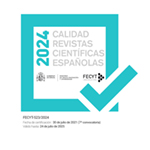Gesto y rango en el arte maya clásico
Resumen
Los artistas mayas del periodo Clásico, especialmente en su fase tardía (600-800 d.C.), cristalizaron un sistema o aparato de convenciones visuales, cuya finalidad era enaltecer y glorificar la figura de sus k’uhul ajawtaak o señores divinos. El estudio de este corpus de estrategias, que apenas está en sus albores, constituye el tema de reflexión de este artículo, que por sus dimensiones no es un estudio exhaustivo, sino más bien introductorio. Éstas incluyen la división jerárquica del campo pictórico, la manipulación de escalas y volúmenes, el uso de determinada indumentaria y parafernalia política y ritual, la presencia de títulos de cargo y rango escritos en las glosas, las interacciones entre los personajes, los recursos del halo o hueco jerárquico, ángulos simultáneos de visión, principio de diferenciación, escalonamiento vertical de las figuras, actitud isocefálica entre personajes del mismo estatus, distanciamiento emocional entre el gobernante y los individuos de bajo rango y la tensión psicológica que se produce entre recursos narrativos vernáculos y hieráticos-idealizados de filiación teotihuacana, todo lo cual en su conjunto es lo que le da sentido y significado a las posturas, gestos y ademanes, que suelen resaltar sobre fondos neutros o poco recargados, donde el medio ambiente, entorno o panorama es conceptual y minimalista.
Descargas
Descarga artículo
Licencia
La Revista Española de Antropología Americana, para fomentar el intercambio global del conocimiento, facilita el acceso sin restricciones a sus contenidos desde el momento de su publicación en la presente edición electrónica, y por eso es una revista de acceso abierto. Los originales publicados en esta revista son propiedad de la Universidad Complutense de Madrid y es obligatorio citar su procedencia en cualquier reproducción total o parcial. Todos los contenidos se distribuyen bajo una licencia de uso y distribución Creative Commons Reconocimiento 4.0 (CC BY 4.0). Esta circunstancia ha de hacerse constar expresamente de esta forma cuando sea necesario. Puede consultar la versión informativa y el texto legal de la licencia.









